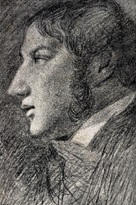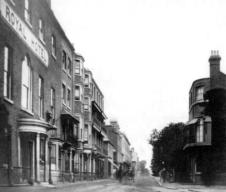1800
Bridge over Prittlewell Brook was rebuilt.
It
was
established
that
in
1800
the
largest
property
owner
in
Southend
was
James
Heygate,
practically
owning
the
majority
of
all
the
new
buildings
being
built
around
the
seafront
area.
He
was
well
revered
as
he
made
improvements
and
brought
the
place
to
public
notice.
1801
In 1801 there were 1,213 inhabitants in Southend.
Lord
Nelson
in
town.
Was
it
coincidence
or
design
that
Lord
Nelson,
from
1801
and
for
the
next
few
years
would
be
seen
in
Southend.
Yes
in
1801
he
was
duty
bound
as
he
was
commanding
the
battle
squadron
that
was
defending
the
Thames
Estuary
and
the Eastern Coast. He would tie up his flagship at the Nore providing him ample time to spend with his mistress Lady Hamilton.
Royal
Patronage.
Princess
Charlotte
of
Wales,
daughter
of
George
IV,
visited
Southend
for
sea-bathing,
as
advised
by
her
physicians.
She
stayed
at
The
Lawn,
Southchurch
and
attended
service
at
Holy
Trinity
Church,
Southchurch,
as
well
as
patronising
the
bathing
machines of Mrs Glasscock.
Leigh
Brewery
closes.
The
first
proper
brewery
in
the
borough
closed.
The
George
Brewery
in
the
old
town
Leigh
ran
from
around
1714.
1802
Jetty
built.
Southend
was
building,
hotels
emerging
and
the
need
for
transport
was
never
more
paramount.
Sir
Thomas
Wilson
bridged
this
gap
a
little,
as
owner
of
a
property
on
Royal
Terrace,
he
erected
the
New
Pier,
a
jetty
opposite
the
Royal
Hotel;
and
'hards,' down which horse drawn vans might be driven to collect baggage were built by the owners of the Ship and Royal Hotels.
Southend (village) had fifty one houses.
1803
Princess Caroline of Brunswick (wife of the Prince Regent, afterwards George IV) visits Southend.
During
the
Napoleonic
Wars
it
was
thought
that
the
French
might
attempt
a
landing
on
the
north
bank
of
the
Thames
Estuary.
Jonas
Asplin
of
Wakering
and
John
Lodwick
of
Southend,
raised
and
commanded
a
troop
of
volunteer
cavalry
and
a
company
of
infantry
respectively,
to
resist
any
attempted
invasion.
The
military
based
in
Southend
would
defend
the
land
but
come
the
need
would
'scorch
the
earth'
as
they
retreated
in
land.
Buildings
and
crops
would
be
set
alight.
Animals
would
be
slaughtered,
roads
and
bridges
destroyed. In the event the Napoleonic forces did not attack and moved eastwards instead.
1804
Ingram builds his warm baths below the Royal Hotel.
The
Southend
Theatre,
Southend’s
first
theatre
was
built
by
Thomas
Trotter,
between
the
Minerva
Hotel
and
the
old
Castle
Inn
along
Eastern
Esplanade,
to
replace
the
original
one
which
stood
by
the
Hope.
A
well
known
figure
at
the
time
Admiral
Rowley
would
be
seen
acquainting
himself
of
the
theatrics
here,
he
was
also
friendly
with
an
actress,
Mrs
Powell,
who
at
the
end
of
performances
of
"Children
in
the
Wood."
It
is
known
that
Lady
Hamilton
frequented
the
place.
This
popular
theatre
was
sold
on
in
1812
to
Mr.
Samuel Jerrold and finally demolished in 1858.
The
Lawn's
in
Southchurch
had
a
secret
resident
during
1804.
Lady
Hamilton,
during
her
time
here
she
gave
birth
to
her
second
daughter,
Emma,
and
it
is
thought
although
not
clarified
that
Lord
Horatio
Nelson
could
well
have
been
in
attendance
at
the
birth
due
to
his
Naval
movements
around that time.
1805
With
recent
Royal
stays
of
Princesses
Charlotte
and
Caroline,
in
this
new
somewhat
exclusive
resort
with
recommended
sea
bathing
health
benefits.
It
was
no
surprise
that
areas
where
they
stayed
soon
amended
their
business
names
to
reflect
Royal
patronage.
Up
until
now
the
Capitol
Hotel
that
stood
proud
at
the
top
of
Pier
Hill
would
change
its
name
to
the
one
we
all
know
it
to
be
today the 'Royal' Hotel.
Nelson's
flagship
HMS
Victory
could
be
seen
just
off
Southend
this
year
waiting
in
the
waters
before
needing
some
work
done
at
Chatham dockyards, repairing damage acquired during the Battle of Trafalgar.
1806
A
chapel
was
built
in
the
High
Street
just
north
of
the
junction
with
Clarence
Street;
it
served
until
1864,
with
the
Cliff
Town
Church
being built in the following year.
The
“Globe,”
began
to
publish
a
list
of
Society
visitors
to
the
now
fashionable
resort,
and
so
popular
was
the
town
that
the
local
inns
were not large enough to accommodate all the visitors.
British School opened in the High Street.
A whale, 34 feet in length, was stranded in Leigh Marsh and was towed by barge to Leigh.
1809
The
Shrubbery
is
planted.
Lady
Langham
planted
and
enclosed
a
little
grove
of
trees
at
the
western
extremity
of
what
is
now
known
as the Shrubbery in commemoration of the jubilee of George III.
1811
13th October. Daniel Scratton died, Squire of the manor of Prittlewell and long time resident of the Priory.
1813
The
King's
Bench
Division
decided
this
year
that
Milton
was
a
separate
parish
for
the
maintenance
of
highways.
Milton
as
a
name
goes
right
back
to
1225
when
it
was
mentioned
as
a
port.
It
would
seem
that
the
port
was
once
a
separate
parish
as
the
remains
of
a
church submerged by the encroaching sea during the 14th-17th centuries, could still be seen right up to the 1840s.
1814
New
Prittlewell
water
pump
is
erected
by
the
parish,
original
one
was
removed
when
the
bridge
over
Prittlewell
Brook was rebuilt in 1800.
A
Painter
drops
by.
The
renowned
English
painter
John
Constable
visited
Southend;
well
known
to
have
associations
with
Old
Leigh,
where
a
relative
lived.
The
Beecroft
Art
Gallery
in
Station
Road,
Westcliff
used
to
hold certain works by Constable some permanent and others on loan.
1817
The
Dole-ites
Named
and
Shamed.
At
this
time
the
poor
were
often
picked
on
for
being
idle,
there
was
plenty
work
needed
doing
around
the
town.
It
was
therefore
agreed
by
the
ratepayers
that
the
names
of
the
unemployed
should
be
pinned
up
in
the
tap
rooms
of the pubs of Prittlewell and Southend in an attempt to shame them into work.
1818
The
first
Castle
Pub
was
constructed
on
the
seafront.
It
took
a
while
to
build
but
the
the
Castle,
which
no
longer
exists
(demolished
in
1924),
sat
on
the
current
footprint
of
the
Sea
Life
Centre.
The
first
licensee
was
a
Thomas
Brown.
The
positioning
of
the
pub
was
as
close as you could get to the beach ideal for trippers looking for a beanfeast and a bed.
Smallpox,
this
illness
was
common
until
the
beginning
of
the
last
century.
Nationally
a
vaccination
had
been
introduced
in
1796,
but
was first adopted locally in Southend and Prittlewell, in 1818.
1819
First
steamboat
service
started.
Southend
began
providing
pleasure
trips
long
before
the
pier
was
built,
which
caused
a
bit
of
an
issue
for
the
ladies
in
long
attire
not
getting
wet
alighting
from
boats.
Invariably
they
would
be
loaded
(manhandled)
from
the
steam
boats
into
flat
bottomed
rowing
boats
which
were
towed
by
horse
or
man
to
shore.
This
did
not
deter
willing
trippers
who
all
thought
it
was
all part of the experience then of visiting Southend.
Timeline

Southend Timeline Southend-on-Sea © 2009 - 2024. All Rights Reserved
1800 - 1819



John Constable
Royal Hotel Pier Hill


Website Info:

Southend-on-Sea’s No 1 History Website! Documenting The Town & The Townspeople
Now Incorporating The Sea Of Change Website


SOUTHEND CITY
Chalkwell ▪ Eastwood ▪ Leigh-on-Sea ▪ Prittlewell ▪ Shoeburyness ▪ Southchurch ▪ Thorpe Bay ▪ Westcliff-on-Sea
































































